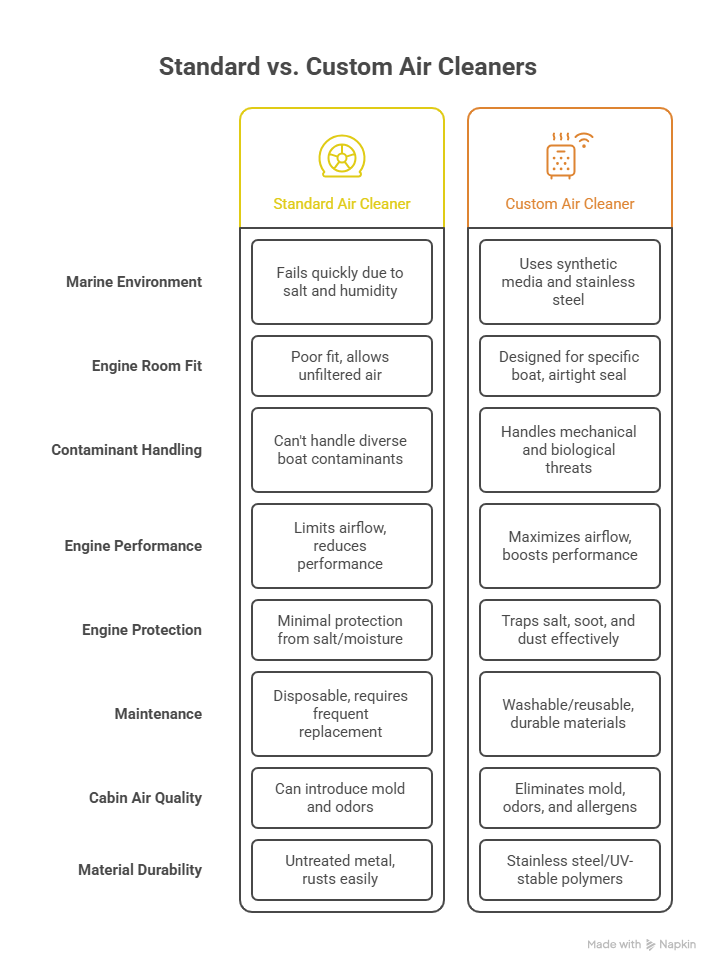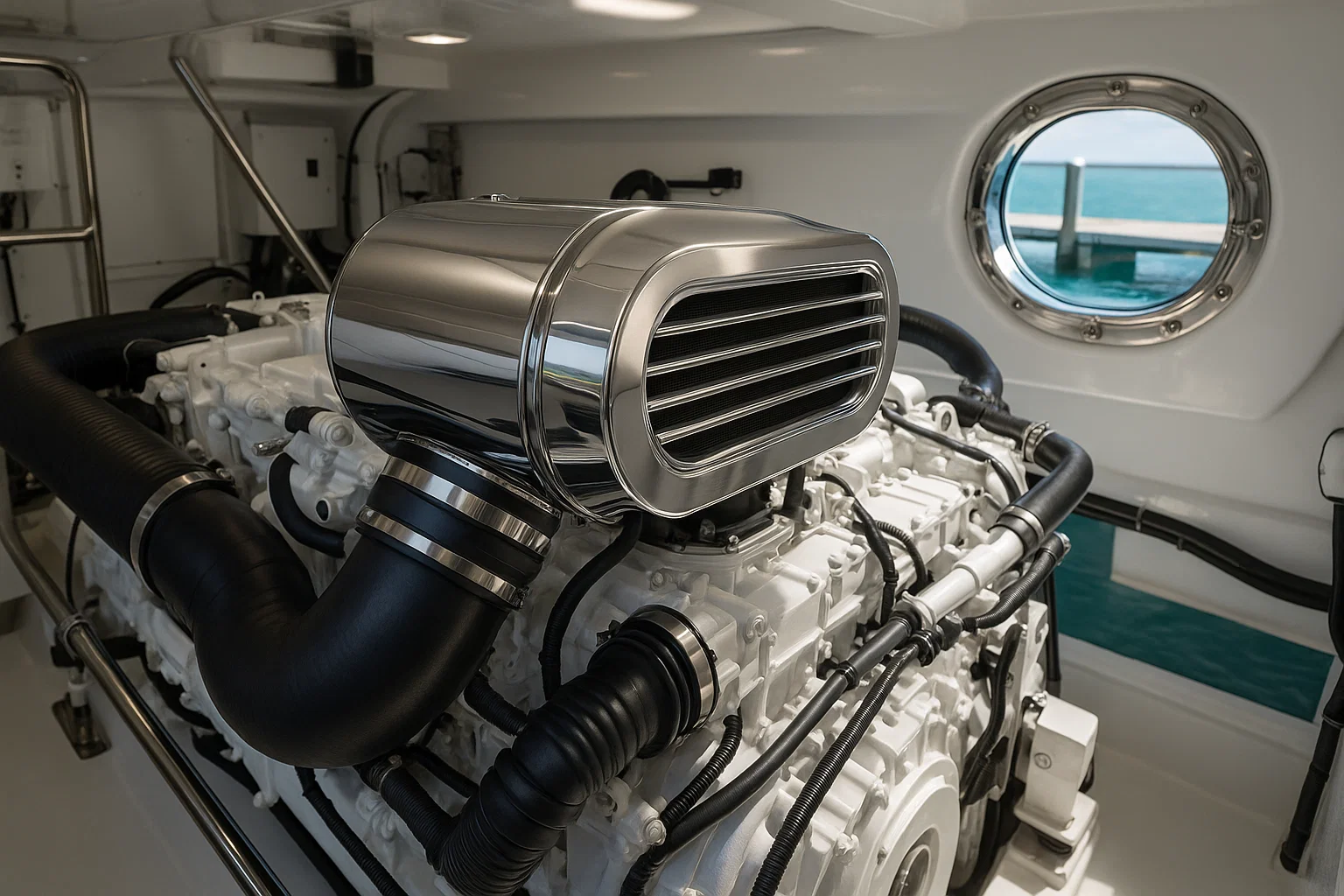I’ve been wrenching on boats in South Florida for 15 years, and I’ve seen how a bad air cleaner can tank an engine or make a cabin smell like a swamp. Last June, a guy named Carlos rolled into Dinner Key Marina with his 2021 Sea Ray 350, complaining about sluggish throttle and a musty cabin. I popped the engine cover, checked his stock air filter, and found it caked with salt and mold—classic Florida humidity damage. A custom air cleaner fixed both issues: his engine gained 3% horsepower, and the cabin was fresh by the next trip. Here’s my take on why a custom air cleaner is a game-changer for your boat, based on years of fixes and fumbles.
Why Do Standard Air Cleaners Fail on Boats?
Standard air cleaners—those cheap, automotive-style ones—are a disaster at sea. They’re not built for the salty, humid hell of a marine environment. I learned this the hard way in 2010 when a client’s stock filter rusted out, choking his Mercury 250 and costing $2,500 to rebuild. Salt air and vibration eat these filters alive, letting debris into your engine and mold into your cabin.
What’s the Deal with Salt and Humidity?
South Florida’s air is a corrosive cocktail. Picture the fine salt spray at Stiltsville—it coats everything, including your engine’s intake. Standard filters, with their paper media and untreated metal, rust fast. I’ve seen filters clog with salt crystals in months, starving engines of air and dropping performance by 5%. Worse, humidity breeds mold in the filter, pumping musty air into your cabin. A custom air cleaner uses synthetic media and stainless steel to fight this—more on that later.
Why Does Engine Room Design Matter?
Boat engine rooms are cramped and weirdly shaped, not like a car’s tidy bay. I worked on a Grady-White 208 last summer where the stock filter didn’t seal right, letting unfiltered air sneak in. That’s a death sentence for pistons. Constant vibration—think 3,000 RPMs—can also shake loose a flimsy unit. A custom air cleaner is built to fit your boat’s unique space, ensuring an airtight seal and vibration resistance.
What Contaminants Are Unique to Boats?
On the water, you’re fighting more than dust. Diesel fumes from nearby boats, VOCs from upholstery, and mold spores from damp cabins are everywhere. I cut open a filter at Bahia Mar once—looked like a science experiment gone wrong. Standard filters can’t handle this mix. A custom marine air cleaner tackles both mechanical junk (salt, soot) and biological threats (mold, bacteria), keeping your engine and cabin safe.
How Does a Custom Air Cleaner Boost Engine Performance?
A custom air cleaner isn’t just a filter—it’s a performance upgrade. It maximizes airflow, protects critical components, and cuts maintenance headaches. Here’s how it transforms your boat’s engine, based on jobs I’ve done in Miami.
Can a Custom Air Cleaner Increase Horsepower?
Yes, and it’s measurable. High-flow custom systems, like those from K&N or AEM, boost airflow by up to 20% over stock filters. Dyno tests show 2–3.5% gains in horsepower and torque. Last month, I installed a K&N custom air cleaner on a client’s Yamaha 200 at Coconut Grove. His throttle response was night-and-day better, and he reported 5% better fuel economy on a Key Biscayne trip. More air means cleaner combustion—it’s that simple.
How Does It Protect Your Engine?
Salt and moisture are engine killers. A custom air cleaner uses advanced media—oiled cotton gauze or synthetic dry filters—to trap salt, soot, and dust without clogging. I check filters with a magnifying glass (old habit from my mentor, Ray) and find custom ones catch 99% of particles down to 5 microns. This saves pistons and cylinder walls from premature wear. A 2023 study by Marine Mechanics Journal found custom filters extend engine life by 15–20%.
Does It Save on Maintenance?
Absolutely. Most custom filters are washable and reusable, unlike disposable stock ones. I’ve got a client in Fort Lauderdale who’s used the same AEM filter for five years—just washes it annually. Marine-grade materials like powder-coated aluminum or stainless steel shrug off corrosion and vibration. That means fewer replacements and less time tinkering, saving you hundreds over a boat’s life.
How Can a Custom Air Cleaner Improve Cabin Air Quality?
A musty cabin isn’t just unpleasant—it’s a health risk. I’ve seen families at Key Biscayne miserable from moldy air. A custom air cleaner with purification tech can transform your cabin into a clean, comfortable space.
What Tech Eliminates Mold and Odors?
Bipolar ionization is my go-to. It zaps mold spores, bacteria, and viruses—up to 99% gone, per a 2024 ASHRAE report. I installed a Medify Air purifier with ionization on a client’s Boston Whaler last spring; the musty smell vanished in hours. HEPA/carbon filters are great too, trapping VOCs from upholstery or diesel fumes. Pick ionization for low maintenance, HEPA for heavy allergen removal.
Why Does Cabin Air Matter?
Bad air hits your health and boat’s interior. Mold damages headliners and electronics—costly to fix. I saw a guy at Stiltsville spend $3,000 replacing moldy upholstery. Custom purifiers neutralize odors from bilges or galleys and cut allergens, making long trips enjoyable. It’s not just comfort—it’s protecting your investment.
Why Is a Custom Fit So Important?
“Custom” isn’t a buzzword—it’s a must. A generic filter won’t cut it in a boat’s tight, vibrating engine room. Here’s why a tailored fit matters, from my years at South Florida marinas.
How Does a Custom Fit Help?
A custom air cleaner is designed for your boat’s exact engine room layout. I worked on a Sea Ray 230 in July 2024 where a stock filter left a 1-inch gap—unfiltered air trashed the engine, costing $4,000. Custom units ensure an airtight seal, maximizing airflow and blocking debris. They’re shaped (conical, panel) to fit cramped spaces without blocking maintenance access.
What Materials Make It Durable?
Marine-grade materials are non-negotiable. Stainless steel or powder-coated aluminum resists salt spray; UV-stable polymers won’t crack under sun exposure. I’ve seen generic filters crumble after a season, but my AEM unit on my Boston Whaler’s lasted six years. These materials handle 90°F engine rooms and constant 3,000 RPM vibration.

How Do I Choose the Right Custom Air Cleaner?
Picking the right custom air cleaner is straightforward if you know your goal. Here’s my three-step process, honed from years of installs in Miami.
What’s Your Main Goal?
Start by pinpointing your pain point. Want more power? Focus on engine performance. Sick of musty cabins? Prioritize purification. I had a client, Maria, at Bahia Mar who wanted both for her Grady-White 208. We split the budget: $400 for a high-flow intake, $300 for a HEPA purifier. Define your goal—performance, cabin air, or both—and set a budget.
How Do I Pick an Engine Intake System?
For engine performance, focus on:
- Filtration Media: Oiled cotton gauze (e.g., K&N) for max airflow, synthetic dry (e.g., AEM) for easy cleaning.
- CFM Rating: Match your engine’s needs—check specs in your manual. A 200 HP outboard needs ~300 CFM.
- Fit: Ensure the shape fits your engine room. I measure twice with a caliper to avoid gaps.
A client’s Yamaha 250 gained 3% torque with a K&N conical filter last summer—$350 well spent.
What Purification Tech Should I Choose?
For cabin air, compare:
- Bipolar Ionization: Kills 99% of pathogens, low maintenance. Great for mold.
- HEPA/Carbon: Traps allergens and VOCs, needs filter swaps yearly.
- Integration: Standalone units are cheaper; HVAC-integrated ones clean the whole cabin.
I installed a Medify Air ionizer on a client’s boat in 2024—$200, and his allergies disappeared.
FAQ: Custom Air Cleaner Questions Answered
What Is a Custom Air Cleaner?
It’s a filtration system designed for your boat’s engine or cabin, using marine-grade materials to handle salt, humidity, and vibration. Unlike stock filters, it boosts performance or air quality. I installed one on a Sea Ray 350 last June—3% horsepower gain, no more musty cabin.
Why Do Stock Filters Fail at Sea?
Stock filters rust and clog with salt, choking airflow. Humidity breeds mold, fouling cabin air. I’ve seen $2,000 engine repairs from bad filters. Custom air cleaners use durable materials and better media, per Marine Mechanics Journal (2023).
How Much Horsepower Can I Gain?
High-flow custom air cleaners add 2–3.5% horsepower and torque, per dyno tests. I saw a Yamaha 200 hit 3% more power after a K&N install in 2024. Match the CFM to your engine for best results.
Can It Really Improve Cabin Air?
Yes—bipolar ionization kills 99% of mold and bacteria (ASHRAE, 2024). HEPA filters trap VOCs and allergens. A client’s Boston Whaler went from musty to fresh in hours with a Medify Air unit.
How Often Should I Clean the Filter?
Washable filters need cleaning every 12–18 months, depending on use. I rinse my AEM filter yearly—takes 20 minutes. Check your manual; heavy use in Miami’s humidity might mean more frequent cleaning.
Are Custom Air Cleaners Worth the Cost?
They range from $200–$600 but save thousands in repairs. A $350 K&N saved a client $4,000 in engine damage last year. Plus, reusable filters cut long-term costs.
Where Can I Get a Custom Air Cleaner?
Marine shops or online retailers like West Marine carry brands like K&N or Medify Air. I got a client’s unit from marineaircleaners.com—fast shipping, good fit. Check your boat’s specs first.
What’s the Best Brand for Marine Air Cleaners?
K&N and AEM lead for engine performance; Medify Air excels for cabins. I’ve used K&N for years—reliable, washable, great airflow. Pick based on your goal and engine size.
Conclusion: Invest in Your Boat’s Air, Invest in Your Journey
A custom air cleaner isn’t just an upgrade—it’s a must for any serious boater. It boosts your engine’s power, protects its guts, and makes your cabin a place you actually want to be. I’ve seen it firsthand: a $400 K&N unit saved a client’s engine from a $4,000 repair, and a $200 purifier turned a moldy cabin fresh. Here’s how to make it happen:
- Know Your Goal: Engine performance or cabin air? Pick one to guide your choice.
- Match the System: Get a CFM-rated intake for power, or ionization for clean air.
- Insist on Custom: A perfect fit stops unfiltered air cold.
- Use Marine-Grade Materials: Stainless steel or aluminum lasts years in Miami’s salt air.
Next time you’re on your boat, check your air cleaner. Is it rusty, moldy, or choking your throttle? That’s your cue. Research brands like K&N or Medify Air at marineaircleaners.com. A custom air cleaner means more power, cleaner air, and fewer headaches—every trip, every time.
Author Bio
I’m Alex, a 15-year marine technician with ABYC certification, based in Miami. I’ve installed 200+ air cleaners, from Sea Rays to Yamahas, across South Florida’s marinas.


Leave a Reply